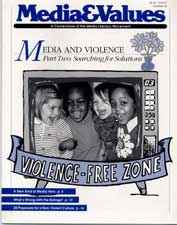Taking a Stand: A Postcard Campaign for Nonviolent Media
|
This article originally appeared in Issue# 63
|
EDITOR'S NOTE: With the growth of the Internet and e-mail, this postcard campaign may seem outdated. But the basic principles here are timeless and with e-mail, it's even easier to organize a campaign to express your point of view.
On January
l5, l993, Mary Beth Boesen went to enjoy Denver's annual
celebration for Dr. Martin Luther King, one of the U.S.'
great non-violent heroes. "It was a beautiful day,"
Boesen recalls. "There were speeches and a huge birthday
cake. Lots of people turned up, old and young, people of
all colors." The press attended too. Boesen noticed a
reporter from Channel 4 News who was interviewing people
about what the holiday meant to them.
After the
commemoration, Boesen went home and turned on the TV news
to see if she would see anyone she knew. The lead story
that night on the local news was about 30 neo-Nazi
counterdemonstrators who got into a screaming match with
the mayor. The second story was about another group of
kids that got into a brawl and beat up a young woman and
threw rocks into windows. The peaceful, joyous
celebration that Boesen had attended was the third story
in the news line-up. Boesen, a member of Stand Against
Violence Everywhere (SAVE) a project of the Loretto
Women's Network, was furious. "That was the message kids
were getting," she says. "If you're violent, you get news
coverage."
She picked up
the phone and called the TV station. "I was pretty
'wrathy,'" she says, "and they finally let me talk to an
associate producer." As a result of Boesen's phone call,
the station re-organized and re-edited their coverage for
the l0 o'clock broadcast. "They put the peaceful
demonstration first, they gave it equal time, and they
cut out the kids screaming at the mayor," Boesen
says.
That night was
the beginning of what became a coordinated campaign among
the approximately 650 members of the Loretto Women's
Network. Members began sending postcards to national
media and calling local media (followed up by a letter)
when they saw violence glorified or when they saw a news
station doing a responsible job.
Boesen and
SAVE's work didn't take a lot of time or money. They use
standard issue, pre-paid post office postcards. It's an
idea that any individual and any group can readily
adapt.
Here are some
sample postcards that SAVE used. And be sure to see
How to Organize a Local Postcard Campaign
for tips on how to implement this activity in any
community organization.
Sample Postcard #1
|
Sample Postcard #2
|



